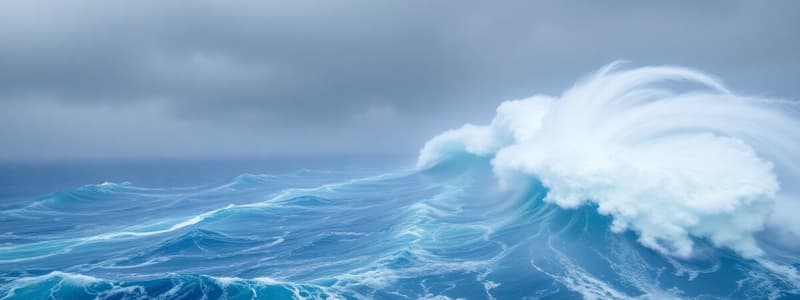Podcast
Questions and Answers
What happens to a typhoon when it moves over land?
What happens to a typhoon when it moves over land?
- It gains strength from moisture loss.
- It intensifies due to land heat.
- It deteriorates as the air over land cools. (correct)
- It changes direction due to high pressure.
Which part of a typhoon is considered the most dangerous?
Which part of a typhoon is considered the most dangerous?
- The eye wall (correct)
- The rain bands
- The surrounding waters
- The eye
What geographical feature contributes to the Philippines' vulnerability to typhoons?
What geographical feature contributes to the Philippines' vulnerability to typhoons?
- Dense forest cover absorbing moisture
- Proximity to the equator and ocean currents (correct)
- High mountains blocking winds
- The lack of bodies of water
What climatic condition is significant in the formation of typhoons?
What climatic condition is significant in the formation of typhoons?
During which months does the northeast monsoon typically occur in the Philippines?
During which months does the northeast monsoon typically occur in the Philippines?
What is the primary factor that contributes to the formation of a typhoon?
What is the primary factor that contributes to the formation of a typhoon?
During which months do tropical cyclones typically occur in the Northern Hemisphere?
During which months do tropical cyclones typically occur in the Northern Hemisphere?
What role does the Coriolis effect play in typhoon formation?
What role does the Coriolis effect play in typhoon formation?
Which of the following is NOT a factor that weakens a typhoon?
Which of the following is NOT a factor that weakens a typhoon?
Which type of cyclone occurs in the Northwest Pacific Ocean?
Which type of cyclone occurs in the Northwest Pacific Ocean?
How many tropical cyclones enter the Philippine Area of Responsibility each year?
How many tropical cyclones enter the Philippine Area of Responsibility each year?
What is a tropical depression?
What is a tropical depression?
Which statement about typhoons and hurricanes is true?
Which statement about typhoons and hurricanes is true?
Flashcards
Typhoon Deterioration
Typhoon Deterioration
A typhoon weakens when its eye moves over land because the air cools quickly, reducing intensity.
Wind Shear
Wind Shear
Difference in wind speed and/or direction at different altitudes in the atmosphere.
Typhoon Eye
Typhoon Eye
The calm, clear center of a typhoon with low pressure and warm temperatures.
Typhoon Eye Wall
Typhoon Eye Wall
Signup and view all the flashcards
Typhoon Formation
Typhoon Formation
Signup and view all the flashcards
Typhoon
Typhoon
Signup and view all the flashcards
Cyclogenesis
Cyclogenesis
Signup and view all the flashcards
Tropical Cyclone
Tropical Cyclone
Signup and view all the flashcards
PAGASA
PAGASA
Signup and view all the flashcards
Typhoon Formation Factors
Typhoon Formation Factors
Signup and view all the flashcards
Typhoon Weakening Factors
Typhoon Weakening Factors
Signup and view all the flashcards
Typhoon vs. Hurricane
Typhoon vs. Hurricane
Signup and view all the flashcards
Tropical Depression
Tropical Depression
Signup and view all the flashcards
Study Notes
Learning Goals
- Understand typhoon development and how landmasses and bodies of water affect them.
True or False
- Typhoons are larger than cyclones, which are larger than hurricanes. (False)
- Hurricanes are stronger than typhoons and cyclones. (False)
- Hurricanes, typhoons, and cyclones are the same but occur in different regions. (True)
Did You Know That...
- PAGASA (Philippines Atmospheric, Geophysical and Astronomical Services Administration) reports around 20 tropical cyclones entering the Philippine Area of Responsibility annually.
Typhoon Regions
- Hurricanes occur in the North Atlantic Ocean and Northeast Pacific.
- Typhoons occur in the Northwest Pacific Ocean, near the South China Sea.
- Cyclones occur in the South Pacific and Indian Ocean.
Tropical Cyclone
- Tropical cyclone is a general term for a rotating system of clouds and thunderstorms that originates over tropical or subtropical waters with a closed, low-level circulation.
- Tropical depressions are the weakest tropical cyclones.
Tropical Cyclone Occurrence
- Tropical cyclones occur annually during late summer in the Northern Hemisphere (July-September) and in the Southern Hemisphere (January-March).
Intertropical Convergence Zone (ITCZ)
- The ITCZ influences the location of typhoons.
- The ITCZ is observed at a maximum latitude of 20-25 degrees North in July and 20-25 degrees south in January.
Check Up
- How many typhoons enter the Philippines every year? (Around 20)
- What is PAGASA? (Philippines Atmospheric, Geophysical and Astronomical Services Administration)
- What is the difference between typhoons and hurricanes? (They are the same but occur in different geographic areas)
- Why are typhoons given a name? (The info is not included here)
Cyclogenesis (Typhoon Development)
- Cyclogenesis is the process of a cyclone's development and strengthening.
- Causes of tropical cyclones include pre-existing weather disturbances, warm tropical oceans, moisture, and relatively light winds.
Typhoon Formation Processes
- Evaporation of water on the ocean surface (26.5-27 degrees Celsius)
- Convergence of air masses with different characteristics
- High humidity
- Rising warm air cooling to form clouds
- Coriolis effect creating spin
Factors Weakening Typhoons
- Cold waters: reduce moisture, depriving the typhoon of fuel.
- Landfall: causes rapid cooling of the air, reducing intensity.
- Wind shear: differences in wind speed weaken the typhoon.
Typhoon Anatomy
- Eye: Central area of calm weather, clear skies, warm temperatures, and low atmospheric pressure.
- Eye Wall: Most dangerous part with strongest winds and heaviest rainfall.
- Rain Bands: Compact regions of vertical air movement surrounding the eye, forming clouds that spin.
Typhoon Effects
- Strong winds
- Tornadoes
- Rainfall and flooding
- Storm surge
Philippine Typhoon Proneness
- The Philippines lies on the western rim of the Pacific Ocean, north of the equator.
- It's surrounded by bodies of water (West Philippine Sea, Pacific Ocean, Bashi Channel, Sulu Sea, Celebes Sea) within the tropical zone.
- The tropical climate and monsoons (northeast from November to April and southwest from May to October) contribute to typhoon formation and frequency.
Studying That Suits You
Use AI to generate personalized quizzes and flashcards to suit your learning preferences.




